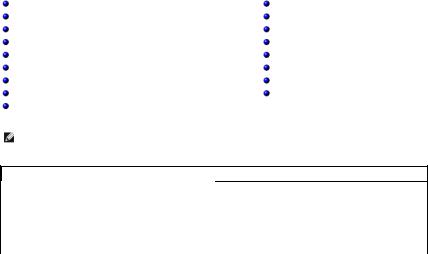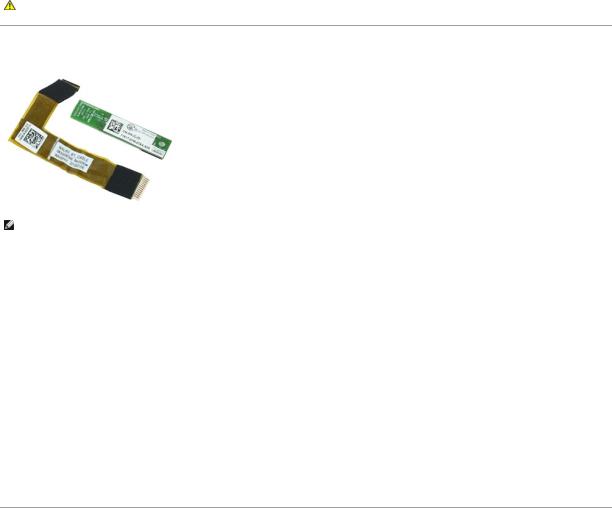Dell E4310 User Manual

Dell Latitude E4310 Service Manual
Working on Your Computer
Removing and Replacing Parts
Specifications
Diagnostics
System Setup
Notes, Cautions, and Warnings
NOTE: A NOTE indicates important information that helps you make better use of your computer.
CAUTION: A CAUTION indicates potential damage to hardware or loss of data if instructions are not followed.
WARNING: A WARNING indicates a potential for property damage, personal injury, or death.
If you purchased a Dell n Series computer, any references in this document to Microsoft Windows operating systems are not applicable.
Information in this document is subject to change without notice.
© 2010 Dell Inc. All rights reserved.
Reproduction of this material in any manner whatsoever without the written permission of Dell Inc. is strictly forbidden.
Trademarks used in this text: Dell™, the DELL logo, Latitude ON™, and Latitude™ are trademarks of Dell Inc. Intel®, Pentium®, Celeron®, Intel® SpeedStep™, Intel® TurboBoost™, and Core™ are either trademarks or registered trademarks of Intel Corporation. Bluetooth® is a registered trademark owned by Bluetooth SIG, Inc. and is used by Dell under license. Microsoft®, Windows®, Windows Vista®, and the Windows Vista start button are either trademarks or registered trademarks of Microsoft Corporation in the United States and/or other countries.
Adobe®, the Adobe logo, and Flash® are either registered trademarks or trademarks of Adobe Systems Incorporated in the United States and/or other countries.
Other trademarks and trade names may be used in this document to refer to either the entities claiming the marks and names or their products. Dell Inc. disclaims any proprietary interest in trademarks and trade names other than its own.
June 2010 |
Rev. A00 |

Back to Contents Page
System Setup
Dell Latitude E4310 Service Manual
Entering System Setup
Boot Menu
Navigation Keystrokes
System Setup Menu Options
Your computer offers the following BIOS and System Setup options:
•Access System Setup by pressing <F2>
•Bring up a one-time boot menu by pressing <F12>
•Access the Intel AMT settings by pressing <Ctrl> + <P>
Entering System Setup
Press <F2> to enter System Setup and make changes to user-definable settings. If you have trouble entering System Setup using this key, press <F2> when the keyboard lights first flash.
Boot Menu
Press <F12> when the Dell logo appears to initiate a one-time boot menu with a list of the valid boot devices for the computer. Diagnostics and Enter Setup options are also included in this menu. The devices listed on the boot menu depend on the bootable devices installed in the computer. This menu is useful when you are attempting to boot to a particular device or to bring up the diagnostics for the computer. Using the boot menu does not make any changes to the boot order stored in the BIOS.
Navigation Keystrokes
Use the following keystrokes to navigate System Setup screens.
Navigation
Action |
Keystroke(s) |
|
|
Expand and collapse field |
<Enter> |
Exit BIOS |
<Esc> or click Exit |
Apply settings |
click Apply |
Reset defaults |
click Load Defaults |
System Setup Menu Options
The following tables describe the menu options for the System Setup program.
General
Option |
Description |
||
|
Lists the primary hardware features of your computer. There are no configurable options in this section. |
||
|
• |
System Information |
|
System Information |
• |
Memory Information |
|
|
• |
Processor Information |
|
|
• |
Device Information |
|
|
|
||
Battery Information |
Displays the status of the battery and the type of AC adapter connected to the computer. |
||
|
Specifies the order in which the computer attempts to find an operating system. |
||
|
• |
Diskette drive |
|
|
• |
Internal HDD (IRRT) |
|
|
• |
USB Storage Device |
|
|
• |
CD/DVD/CD-RW Drive |
|
Boot Sequence |
• |
Onboard NIC |
|
• |
Cardbus NIC |
||
|
|||
|
To change the order in which the computer attempts to find an operating system, select the device to be changed in |
||
|
the list then click the up/down arrows or use the keyboard <PgUp> or <PgDn> keys to change the boot order of the |
||
|
device. |
||
|
Clear the check boxes to remove a device from the list of bootable devices. |
||
Date/Time |
Displays current date and time settings. |
||
NOTE: System Configuration contains options and settings related to integrated system devices. Depending on your computer and installed devices, the items listed in this section may or may not appear.
 System Configuration
System Configuration
Option |
Description |
||
Integrated NIC |
Allows you to configure the integrated network controller. The options are: Disabled, Enabled, and Enabled w/PXE |
||
Default Setting: Enabled w/PXE |
|||
|
|||
Parallel Port |
Allows you to configure the parallel port on the docking station. The options are: Disabled, AT, PS2, and ECP |
||
Default Setting: AT |
|||
|
|||
Serial Port |
Allows you to configure the integrated serial port. The options are: Disabled, COM1, COM2, COM3, and COM4 |
||
Default Setting: COM1 |
|||
|
|||
|
Allows you to configure the internal SATA hard-drive controller. The options are: Disabled, ATA, AHCI, and RAID On |
||
SATA Operation |
Default Setting: RAID On |
||
|
NOTE: SATA is configured to support RAID mode. |
||
|
Allows you to enable or disable the following devices: |
||
|
• |
External USB Port |
|
|
• |
Microphone |
|
|
• |
eSATA Ports |
|
|
• |
Media Card |
|
Miscellaneous Devices |
• |
Internal Modem |
|
|
• |
Fixed Bay |
|
|
• |
ExpressCard |
|
|
• |
Hard Drive Free Fall Protection |
|
|
• |
Camera and Microphone |
|
|
Default setting: All are enabled. |
||
Latitude ON Reader |
Allows you to configure the operating mode of the Latitude ON Reader. |
||
Default Setting: Enable Latitude ON reader |
|||
|
|||
Keyboard Illumination |
Allows you to configure the keyboard illumination feature. The options are: Disabled, Auto ALS and Input, and Auto |
||
Input Only |
|||
|
|||
|
|
|
|
Video |
|
|
|
Option |
Description |
||
Ambient Light Sensor |
Allows you to configure the Ambient Light Sensor. |
||
Default Setting: Disabled |
|||
|
|||
LCD Brightness |
Allows you to set the display brightness depending up on the power source (On Battery and On AC). |
||
|
|
|
|
Security |
|
|
|
Option |
Description |
||
|
Allows you to set, change, or delete the administrator (admin) password. |
||
Admin Password |
NOTE: You must set the admin password before you set the system or hard drive password. |
||
NOTE: Successful password changes take effect immediately. |
|||
|
NOTE: Deleting the admin password automatically deletes the system password as well. |
||
|
Default Setting: Not Set |
||
|
Allows you to set, change, or delete the system password. When set, your computer requests you to enter the system |
||
System Password |
password every time your computer turns on or restarts. |
||
|
|
||
|
Default Setting: Not Set |
||
|
Allows you set, change, or delete the password on the system's internal hard disk drive (HDD). Successful changes |
||
Internal HDD Password |
take place immediately and require a system restart. The HDD password travels with the hard drive, so the HDD is |
||
|
protected even when installed in another system. |
||
|
Allows you to bypass the system and internal hard drive password prompts when your computer restarts or resumes |
||
|
from standby. |
||
|
You can set Password Bypass to: Disabled and Reboot Bypass. |
||
Password Bypass |
|
|
|
|
NOTE: You cannot bypass the system or hard drive password when you turn on your computer that has been |
||
|
turned off. |
||
|
Default Setting: Disabled |
||
|
Allows you to enable of disable changes to the system and hard drive passwords when the admin password is set. |
||
Password Change |
|
|
|
|
Default Setting: Allow Non-Admin Password Changes checked |
||
|
Allows you to enable of disable the option to enforce strong passwords. |
||
|
If enabled, all passwords set on the computer must contain at least one uppercase character, one lowercase character |
||
Strong Password |
and be at least 8 characters long. |
||
|
|
||
|
Enabling this feature automatically changes the default minimum password length to 8 characters. |
||
|
Default Setting: Disabled |
||
|
Allows you to enable or disable the Trusted Platform Module (TPM) on the computer. |
||
|
NOTE: Disabling this option does not change any settings you may have made to the TPM, or delete any information or |
||
|
keys you may have stored there. |
||
TPM Security |
When TPM is enabled, the following options are available: |
||
|
|
||
|
|
|
|

|
• |
Deactivate—Disables the TPM. The TPM restricts access to the stored owner information and does not execute |
|
|
|
any commands that use TPM resources. |
|
|
• |
Activate—Enables and activates the TPM. |
|
|
• |
Clear—Clears the owner information stored in the TPM. |
|
|
Default Setting: Disabled |
||
|
Allows you to enable or disable the optional Computrace software. The options are Deactivate, Disable, and Activate. |
||
Computrace® |
NOTE: The Activate and Disable options will permanently activate or disable the feature and no further changes will |
||
be allowed. |
|||
|
|||
|
Default Setting: Deactivate |
||
|
Allows you to enable or disable the Execute Disable mode of the processor. |
||
CPU XD Support |
|
|
|
|
Default setting: Enabled |
||
|
Allows you to determine whether changes to the system setup options are allowed when an Administrator password is |
||
Non-Admin Setup Changes |
set. If disabled, the system setup options are locked by the admin password. |
||
|
|
||
|
Default Setting: Disabled |
||
Password Configuration |
Allows you to determine the minimum and maximum length of Administrator and System passwords. |
||
Admin Setup Lockout |
Allows you to prevent users from entering system setup when an Administrator password is set. |
||
|
|
|
|
Performance |
|
|
|
Option |
Description |
||
|
Enables or disables multi-core support for the processor. Options are: All, 1, and 2 |
||
Multi Core Support |
|
|
|
|
Default Setting: All |
||
|
Enables or disables the Intel SpeedStep feature. |
||
Intel® SpeedStep™ |
|
|
|
|
Default Setting: Enabled |
||
|
Enables or disables the Intel TurboBoost performance. |
||
Intel® TurboBoost™ |
|
|
|
|
Default Setting: Enabled |
||
Power Management
Option |
Description |
Allows you to enable or disable the computer from turning on automatically when an AC adapter is connected.
AC Behavior
Default Setting: Wake on AC Disabled
Allows you to set the time at which the computer must turn on automatically.
Auto On Time
You can set the number of days, if any, when you would like the system to turn on automatically. The settings are
Disabled, Everyday, or Weekdays.
Default setting: Disabled
Allows you to enable or disable the ability of USB devices to wake the computer from Standby.
This feature is only functional when the AC power adapter is connected. If the AC power adapter is removed when the USB Wake Support computer is in Standby mode, the system setup will remove power from all of the USB ports to conserve battery
power.
Default Setting: Disabled
Allows the computer to turn on by a special LAN signal or from Hibernate mode when triggered by a special wireless LAN signal. Wake-up from the Standby mode is unaffected by this setting and must be enabled in the operating system.
|
• |
Disabled — Do not allow the system to power on when it receives a wake-up signal from the LAN or wireless |
Wake on LAN/WLAN |
|
LAN. |
|
• |
LAN Only — Allow the system to be powered on by special LAN signals. |
|
• |
WLAN Only — Allow the system to be powered on by special WLAN signals. |
|
• |
LAN or WLAN — Allow the system to be powered on by special LAN or wireless LAN signals. |
|
Default Setting: Disabled |
|
|
Allows you to enable or disable the ExpressCharge feature. |
|
ExpressCharge |
NOTE: ExpressCharge may not be available for all batteries. |
|
|
Default Setting: ExpressCharge |
|
|
Allows you to enable or disable the battery charger. |
|
Charger Behavior |
If disabled, the battery will not charge or lose power when the computer is connected to an AC adapter. |
|
|
Default setting: Enabled |
|
|
|
|
POST Behavior |
|
|
Option |
Description |
|
|
Allows you to enable or disable the BIOS warning messages when you use certain power adapters. The BIOS displays |
|
Adapter Warnings |
these messages if you attempt to use a power adapter that has too little capacity for your configuration. |
|
|
|
|
|
The factory default setting is Enabled. |
|
|
Allows you to select one of two methods to enable the keypad that is embedded in the internal keyboard. |
||
|
• |
Fn Key Only — The keypad is only enabled when you hold down the <Fn> key. |
|
|
• |
By Num Lk — The keypad is enabled when (1) the Num Lock LED is on and (2) no external keyboard is attached. |
|
Keypad (Embedded) |
|
Note that the system might not notice immediately when an external keyboard is detached. |
|
|
NOTE: When system setup is running, this field has no effect—system setup works in the Fn Key Only mode. |
||
|
Default setting: Fn Key Only. |
||
|
Allows you to select the pointing devices to use. The options are: |
||
|
• |
Serial Mouse — Disable the integrated touch pad when an external Serial mouse is present. |
|
Mouse/Touchpad |
• |
PS/2 Mouse — Disable the integrated touch pad when an external PS/2 mouse is present. |
|
|
• |
Touchpad-PS/2 — Leave the integrated touch pad enabled when an external PS/2 mouse is present. |
|
|
Default setting: Touchpad-PS/2. |
||
|
Allows you to enable or disable the Num Lock LED when the computer boots. |
||
Numlock LED |
|
|
|
|
Default setting: Enabled. |
||
|
Defines how the system steup handles USB devices. |
||
USB Emulation |
NOTE: USB Emulation is always enabled during POST. |
||
|
Default setting: Enabled. |
||
|
Allows you to use the <Scroll Lock> key on an external PS/2 keyboard the same way you use the <Fn> key on the |
||
|
computer's internal keyboard. |
||
Fn Key Emulation |
NOTE: USB keyboards cannot emulate the <Fn> key if you are running an ACPI operating system such as Microsoft |
||
|
Windows XP. USB keyboards will only emulate the <Fn> key in non-ACPI mode (e.g., when you are running a DOS). |
||
|
Default setting: Enabled. |
||
|
Allows you to enable or disable the Fast Boot feature. The following options are available: |
||
|
• |
Minimal — Boot quickly unless the BIOS has been updated, memory changed, or the previous POST did not |
|
|
|
complete. |
|
Fast Boot |
• |
Thorough — Do not skip any steps in the boot process. |
|
|
• |
Auto — Allow the operating system to control this setting (this works only when the operating system supports |
|
|
|
Simple Boot Flag). |
|
|
Default setting: Minimal |
||
|
Used in conjunction with iAMT 4.0. Allows users to initiate contact with a management console while residing outside of |
||
Intel Fast Call for Help |
the corporate infrastructure (i.e. remote location, behind a firewall or NAT, etc.) Use the check box to enable or disable |
||
|
this feature. |
||
|
|
|
|
Virtualization Support |
|
|
|
|
|
|
|
Option |
Description |
||
|
Specifies whether a Virtual Machine Monitor (VMM) can utilize the additional hardware capabilities provided by Intel |
||
Virtualization |
Virtualization Technology. |
||
|
|
|
|
|
Default setting: Enabled. |
||
|
Specifies whether a Virtual Machine Monitor (VMM) can utilize the additional hardware capabilities provided by Intel |
||
VT for Direct I/O |
Virtualization Technology for Direct I/O. |
||
|
|
|
|
|
Default setting: Disabled. |
||
|
Specifies whether a Measured Virtual Machine Monitor (MVMM) can utilize the additional hardware capabilities provided |
||
|
by Intel Trusted Execution Technology. Virtualization Technology and Virtualization Technology for Direct I/O must be |
||
Trusted Execution |
enabled to use this feature |
||
|
Default setting: Disabled. |
||
|
|
|
|
Wireless |
|
|
|
Option |
|
|
Description |
Wireless Devices |
|
|
Allows you to determine the wireless devices that will be controlled by the wireless switch: Internal WWAN, |
|
|
Internal WLAN, and Internal Bluetooth. |
|
|
|
|
|
Wireless Switch |
|
|
Allows you to enable or disable the following wireless devices: Internal WWAN, Internal WLAN, and |
|
|
Internal Bluetooth. |
|
|
|
|
|
|
|
|
|
Maintenance |
|
|
|
Option |
Description |
||
|
Displays your computer's Service Tag. If for some reason the Service Tag was not already set, you would be able to |
||
|
use this field to set it. |
||
Service Tag |
|
|
|
|
If a Service Tag has not been set for your computer, the computer will automatically bring up the Service Tag screen |
||
|
when you enter the system setup. You will be prompted to enter the Service Tag. |
||
Asset Tag |
Allows you to create an Asset Tag. This field can only be updated if the Asset Tag is not already set. |
||
|
|
|
|
System Logs |
|
|
|
Option |
Description |
||
|
|
|
|
BIOS Events |
Allows you to view and clear BIOS POST events. It includes the date and time of the event as well as the LED code. |
|
DellDiag Events |
Allows you to view the diagnostic results from Dell Diagnostics and PSA. It includes the time and date, the diagnostic |
|
and version which was run and the resulting code. |
||
|
||
Thermal Events |
Allows you to view and clear thermal events. It includes the date and time as well as the name of the event. |
|
Power Events |
Allows you to view and clear power events. It includes the date and time of the event as well as the power state and |
|
reason. |
||
|
||
|
|
|
Back to Contents Page |
|

Back to Contents Page
Diagnostics
Dell Latitude E4310 Service Manual
Device Status Lights
Battery Status Lights
Battery Charge and Health
Device Status Lights
Turns on when you turn on the computer and blinks when the computer is in a power management mode.
Turns on when the computer reads or writes data.
Turns on steadily or blinks to indicate battery charge status.
Turns on when wireless function wireless local area network (WLAN) or WiMAX or wireless wide area network (WWAN) or Bluetooth or Ultra-wide band (UWB) cards is enabled. Use the wireless switch to turn off the wireless function.
Battery Status Lights
If the computer is connected to an electrical outlet, the battery light operates as follows:
•Alternately blinking amber light and blue light — An unauthenticated or unsupported, non-Dell AC adapter is attached to your laptop.
•Alternately blinking amber light with steady blue light — Temporary battery failure with AC adapter present.
•Constantly blinking amber light — Fatal battery failure with AC adapter present.
•Light off — Battery in full charge mode with AC adapter present.
•Blue light on — Battery in charge mode with AC adapter present.
Battery Charge and Health
To check the battery charge, press and release the status button on the battery charge gauge to illuminate the charge-level lights. Each light represents approximately 20 percent of the total battery charge. For example, if four lights are on, the battery has 80 percent of its charge remaining. If no lights appear, the battery has no charge.
To check battery health using the charge gauge, press and hold the status button on the battery charge gauge for at least 3 seconds. If no lights appear, the battery is in good condition and more than 80 percent of its original charge capacity remains. Each light represents incremental degradation. If five lights appear, less than 60 percent of the charge capacity remains, and you should consider replacing the battery.
Back to Contents Page

Back to Contents Page
Removing and Replacing Parts
Dell Latitude E4310 Service Manual
Battery |
Mini Card Door |
Memory Door |
Subscriber Identity Module (SIM) Card |
Hinge Covers |
Secure Digital (SD) Card |
ExpressCard |
LED Covers |
Keyboard |
Hard Drive |
Optical Drive |
Memory |
Coin-Cell Battery |
Wireless Local Area Network (WLAN) Card |
Wireless Wide Area Network (WWAN) Card |
Ultra-Wide Band(UWB)/Latitude ON Flash Card |
Display Assembly |
Display Bezel |
Display Panel |
Microphone Board |
Palm Rest |
Bluetooth Card and Cable |
Display Closure Sensor |
Smart Card Cage |
Speaker Assembly |
System Board |
DC-In Connector |
Heat Sink and Processor Fan |
I/O Board |
|
|
|
Back to Contents Page |
|

Back to Contents Page
Specifications
Dell Latitude E4310 Service Manual
System Information |
Processor |
Memory |
Video |
Audio |
Communications |
Ports and Connectors |
ExpressCards |
Contactless Smart Card (optional) |
Fingerprint Reader (Optional) |
Display |
Keyboard |
Touchpad |
Battery |
AC Adapter |
Physical |
Environmental |
|
NOTE: Offerings may vary by region. For more information regarding the configuration of your computer, click Start ® Help and Support and select the option to view information about your computer.
System Information
Chipset |
Mobile Intel QS57 Express chipset |
|
|
Data bus width |
64 bits |
|
|
DRAM bus width |
64 bits |
|
|
Flash EPROM |
two SPI chips: one 32 Mbits and one 64 Mbits |
|
|
PCI bus |
32 bits |
|
|
Processor |
|
|
|
Types |
Intel Core i3 series |
|
Intel Core i5 series |
|
Intel Core i7 series |
|
|
L1 cache |
32 KB instruction and 32 KB data per core |
|
|
L2 cache |
256 KB |
|
|
L3 cache |
up to 4 MB |
External bus frequency |
1066 MHz |
|
|
|
|
Memory |
|
Type |
DDR3 |
|
|
Speed |
1066 MHz |
|
|
Connectors |
two SODIMM sockets |
|
|
Module capacities |
1 GB, 2 GB, or 4 GB |
|
|
Minimum memory |
1 GB |
|
|
Maximum memory |
8 GB |
|
NOTE: Only 64-bit operating systems support more |
|
than 4 GB memory. |
|
|
|
|
Video |
|
|
|
Type |
integrated on system board |
|
|
Controller |
Intel HD graphics |
|
|
Output |
15-pin VGA connector |
|
|
|
|
Audio |
|
|
|
Type |
two-channel high definition audio |
|
|
Controller |
IDT 92HD81 |
|
|
Speakers |
two |
Internal speaker amplifier |
1 W per channel |
|
|
Volume controls |
volume up, volume down, and mute buttons |
|
|
|
|
Communications |
|
|
|
Network adapter |
Intel 10/100/1000 Ethernet LAN on system board |
|
|
Wireless |
• WLAN half mini card |
|
• WLAN/WiMAX half mini card |
|
• WWAN full mini card |
|
• Bluetooth card |
|
• Ultra-wide band (UWB) card |
|
|

|
|
GPS |
supported by Mobile Broadband full mini card |
|
|
|
|
Ports and Connectors |
|
|
|
Audio |
one combo microphone/headphone connector |
|
|
Video |
15-pin VGA connector |
|
|
Network adapter |
RJ-45 connector |
|
|
USB, eSATA |
• one USB 2.0 compliant connector |
|
• one USB 2.0/eSATA connector |
|
|
Smart-card reader |
integrated smart-card reader |
|
|
Mini card support (internal expansion slots) |
• one dedicated half mini card slot for WLAN |
|
• one dedicated full mini card slot for WWAN |
|
• one half mini card slot for UWB |
|
|
ExpressCards
NOTE: The ExpressCard slot is designed only for ExpressCards. It does NOT support PC Cards.
Cards supported |
34 mm ExpressCards |
|
|
|
|
|
|
|
Contactless Smart Card (optional) |
|
|
|
|
|
Supported Smart Cards/Technologies |
ISO14443A — 106 kbps, 212 kbps, |
|
|
424 kbps, and 848 kbps |
|
|
ISO14443B — 106 kbps, 212 kbps, |
|
|
424 kbps, and 848 kbps |
|
|
ISO15693 |
|
|
HID iClass |
|
|
FIPS201 |
|
|
NXP Desfire |
|
|
|
|
|
|
|
Fingerprint Reader (Optional) |
|
|
|
|
|
Type |
swipe |
|
|
|
|
|
|
|
Display |
|
|
|
|
|
Type |
13.3 inch HD white light-emitting diode (WLED) |
|
|
|
|
Active area (X/Y) |
HD — 293.42 mm x 164.97 mm (11.55 inches x 6.50 |
|
|
inches) |
|
Dimensions: |
|
|
|
|
|
Height |
183.6 mm (7.23 inches) |
|
|
|
|
Width |
308.1 mm (12.13 inches) |
|
|
|
|
Diagonal |
337.82 mm (13.3 inches) |
|
|
|
|
Maximum resolution |
1366 x 768 at 262 K colors |
|
|
|
|
Maximum brightness |
220 nits |
|
|
|
|
Operating angle |
0 degrees (closed) to 135 degrees |
|
|
|
|
Refresh rate |
60 Hz |
|
Viewing angles |
|
|
|
|
|
Horizontal |
40 degrees / 40 degrees |
|
|
|
|
Vertical |
15 degrees / 30 degrees |
|
|
|
|
Pixel pitch |
0.2148 mm |
|
|
|
|
|
|
|
Keyboard |
|
|
|
|
|
Number of keys |
• United States and Canada: 83 keys |
|
|
• |
Europe: 84 keys |
|
• |
Japan: 87 keys |
|
|
|
Layout |
QWERTY/AZERTY/Kanji |
|
|
|
|
Size |
full sized (19.05 mm key pitch) |
|
|
|
|
|
|
|
Touchpad |
|
|
|
|
|
Active area |
|
|
|
|
|
X-axis |
70.00 mm (2.76 inches) |
|
|
|
|
Y-axis |
37.00 mm (1.46 inches) |
|
|
|
|
Resolution |
600 dpi |
|
|
|
|
Battery
Type |
• 3-cell, 2.8 AHr, 30 WHr |
|
• 6-cell, 2.8 AHr, 60 WHr |
|
• 3-year life-time 6-cell, 2.5 AHr, 54 WHr |
|
• battery slice, 48 WHr |
|
|
Charge time with computer off |
• 3-cell 30 WHr, 6-cell 60 WHr, and battery slice |
|
48 WHr — approximately 1 hour to 80% |
|
capacity and 2 hours to 100% capacity |
|
• 6-cell 3-year life-time 54WHr — approximately |
|
3 hours to 100% capacity |
|
|
Operating time |
battery operating time varies depending on operating |
|
conditions and can significantly reduce under certain |
|
power-intensive conditions. |
|
|
Life span (approximate) |
approximately 300 charge/discharge cycles |
Depth |
|
|
|
3-cell |
28.80 mm (1.13 inches) |
|
|
6-cell |
51.10 mm (2.01 inches) |
|
|
Height |
21.90 mm (0.86 inches) |
|
|
Width |
189.80 mm (7.47 inches) |
|
|
Weight: |
|
|
|
3-cell |
0.19 kg (0.42 lb) |
|
|
6-cell |
0.34 kg (0.75 lb) |
battery slice |
0.63 kg (1.39 lb) |
|
|
Voltage |
11.1 VDC (6-cell and 3-cell) |
|
|
Temperature range |
|
|
|
Operating |
0 °C to 35 °C (32 °F to 95 °F) |
|
|
Storage |
–40 °C to 65 °C (–40 °F to 149 °F) |
|
|
Coin-cell battery |
3 V CR2032 lithium |
|
|
|
|
AC Adapter |
|
|
|
Input voltage |
100 VAC–240 VAC |
|
|
Input current (maximum) |
1.5 A |
|
|
Input frequency |
50 Hz–60 Hz |
|
|
Output power |
65 W or 90 W |
|
|
Output current |
|
|
|
65 W |
4.34 A (maximum at 4-second pulse) |
|
3.34 A (continuous) |
|
|
90 W |
5.62 A (maximum at 4-second pulse) |
|
4.62 A (continuous) |
|
|
Output Voltage |
19.5 +/– 1.0 VDC |
|
|
Width |
|
|
|
65 W |
66.00 mm (2.60 inches) |
|
|
90 W |
70.00 mm (2.75 inches) |
|
|
Height |
|
|
|
65 W |
16.00 mm (0.63 inches) |
|
|
90 W |
16.00 mm (0.63 inches) |
Depth |
|
|
|
65 W |
127.00 mm (5.00 inches) |
|
|
90 W |
147.00 mm (5.78 inches) |
|
|
Temperature range |
|
|
|
Operating |
0 °C to 40 °C (32 °F to 104 °F) |
|
|
Storage |
–40 °C to 70 °C (–40 °F to 158 °F) |
|
|
|
|
Physical |
|
|
|
Front height |
26.50 mm (1.04 inches) |
|
|
Back height |
30.53 mm (1.20 inches) |
|
|
Width |
323.00 mm (12.72 inches) |
|
|
Depth |
215.00 mm (8.47 inches) |
|
|
Weight (minimum) |
1.54 kg (3.40 lb) |
|
|
|
|
Environmental |
|
|
|
Temperature range |
|
|
|
Operating |
0 °C to 35 °C (32 °F to 95 °F) |
|
|

Non-operating |
–40 °C to 65 °C (–40 °F to 149 °F) |
Relative humidity (maximum) |
|
|
|
Operating |
10 % to 90 % (noncondensing) |
|
|
Non-operating |
5 % to 95 % (noncondensing) |
|
|
Maximum vibration (using a random vibration spectrum that simulates user environment) |
|
|
|
Operating |
0.66 GRMS |
|
|
Non-operating |
1.3 GRMS |
Maximum shock (measured with hard drive in operating status and a 2-ms half-sine pulse for operating specification; also measured with hard drive in head-parked position and a 2-ms halfsine pulse for storage specification)
Operating |
143 G |
|
|
|
|
Non-operating |
163 G |
|
|
|
|
Altitude (maximum) |
|
|
|
|
|
Operating |
–15.2 m to 3048 m (–50 ft to 10,000 ft) |
|
|
|
|
Storage |
–15.2 m to 10,668 m (–50 ft to 35,000 ft) |
|
|
|
|
|
|
|
Back to Contents Page

Back to Contents Page
Battery
Dell Latitude E4310 Service Manual
WARNING: Before working inside your computer, read the safety information that shipped with your computer. For additional safety best practices information, see the Regulatory Compliance Homepage at www.dell.com/regulatory_compliance.
Removing the Battery
NOTE: You may need to install Adobe Flash Player from Adobe.com in order to view the illustrations below.
1.Follow the procedures in Before Working Inside Your Computer.
2.Slide the battery latch to release the battery.
3.Slide the battery out and remove it from the computer.
Replacing the Battery
To replace the battery, perform the above steps in reverse order.
Back to Contents Page

Back to Contents Page
Bluetooth Card and Cable
Dell Latitude E4310 Service Manual
WARNING: Before working inside your computer, read the safety information that shipped with your computer. For additional safety best practices information, see the Regulatory Compliance Homepage at www.dell.com/regulatory_compliance.
Removing the Bluetooth Card and Cable
NOTE: You may need to install Adobe Flash Player from Adobe.com in order to view the illustrations below.
1.Follow the procedures in Before Working Inside Your Computer.
2.Remove the battery.
3.Remove the ExpressCard.
4.Remove the hard drive assembly.
5.Remove the hinge covers.
6.Remove the mini card door.
7.Remove the LED covers.
8.Remove the keyboard.
9.Remove the display assembly.
10.Remove the palm rest.
11.Remove the screw that secures the Bluetooth card to the palm rest.
12.Disconnect the Bluetooth data cable from the Bluetooth card and remove the Bluetooth card from the computer.
13.Gently release the Bluetooth data cable from the palm rest and remove it from the computer.
Replacing the Bluetooth Card and Cable
To replace the Bluetooth card and cable, perform the above steps in reverse order.
Back to Contents Page
